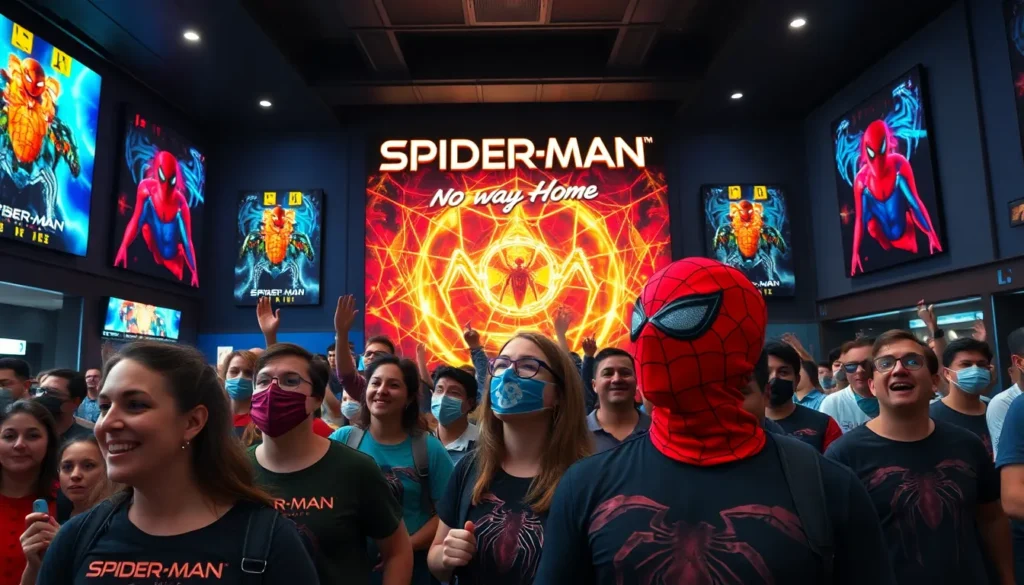When Spider-Man: No Way Home swung into theaters, it didn’t just break records; it shattered them like a villain’s glass fortress. Fans flocked to see their favorite web-slinger in a multiverse adventure that had everyone buzzing. With nostalgia, action, and a sprinkle of humor, this film proved to be a box office juggernaut that left audiences cheering for more.
In a world where superhero fatigue is real, No Way Home reminded everyone why they fell in love with Spidey in the first place. It’s not just a movie; it’s a cultural phenomenon that’s raked in billions and had moviegoers swinging from the rafters. So, grab your popcorn and buckle up as we dive into the astonishing box office performance of this cinematic masterpiece. Who knew saving the universe could be so profitable?
Table of Contents
ToggleOverview of Spider Man No Way Home
“Spider-Man: No Way Home” achieved significant box office success, grossing over $1.9 billion worldwide. This remarkable figure marked it as one of the highest-grossing films in history. Audiences celebrated the film for its nostalgic elements, especially the return of previous Spider-Man actors. It featured Tobey Maguire and Andrew Garfield alongside Tom Holland, creating a shared universe that resonated with fans.
Notably, the film gained attention for its impressive opening weekend. Earning approximately $260 million, it set a record for the December box office, exceeding previous December releases. Many industry analysts attributed this surge to widespread anticipation and a strategic release during the holiday season.
The mix of action, humor, and emotional storytelling contributed to its appeal. Characters faced significant challenges, appealing to both new viewers and long-time fans of the franchise. Critical acclaim from various platforms highlighted the film’s engaging plot and character development.
Social media buzz played a crucial role in its marketing strategy. Fans eagerly discussed theories and shared spoilers, driving excitement and ticket sales. High engagement on online platforms boosted visibility and interest ahead of its release.
Overall, “Spider-Man: No Way Home” revitalized the Spider-Man franchise and demonstrated the ongoing desire for superhero films. The film’s success transcended mere box office numbers, impacting popular culture and showcasing the potential of blockbuster franchises in the current cinematic landscape.
Box Office Performance

“Spider-Man: No Way Home” achieved remarkable box office success, solidifying its status in cinematic history. The film’s financial performance reflects the strong audience demand and effective marketing strategies.
Opening Weekend Earnings
Opening weekend earnings reached around $260 million in the United States. This total marked a record for December releases, driven by heightened anticipation and strategic holiday timing. Audiences flocked to theaters, eager to experience the return of beloved characters. Significant social media buzz also contributed to the excitement surrounding the premiere. Early reviews praised the film, further boosting ticket sales during the first few days.
Total Domestic Gross
Domestically, the film grossed over $814 million. This substantial figure reflects its sustained popularity across weeks of release. Strong word-of-mouth and repeat viewings propelled ticket sales, keeping “No Way Home” at the forefront of box office rankings. Audiences connected with the nostalgic elements and character arcs, encouraging friends and family to watch. Industry analysts noted its impact, as it became one of the highest-grossing films in US history.
Total International Gross
Internationally, “Spider-Man: No Way Home” garnered more than $1 billion. This impressive total highlights its appeal beyond the US market. Strong performances in countries like the UK, Mexico, and Australia contributed significantly to its global earnings. The film’s combination of action, humor, and nostalgia resonated with diverse audiences worldwide. Various international markets embraced “No Way Home,” boosting its overall financial success and affirming the franchise’s global influence.
Factors Influencing Box Office Success
Several key elements contributed to the box office success of “Spider-Man: No Way Home.” The film’s star power and strategic marketing solidified its position as a cultural phenomenon.
Star Power and Fan Base
Star power significantly impacted audience turnout. Tom Holland, Tobey Maguire, and Andrew Garfield, each embodying Spider-Man, generated immense excitement among fans. Nostalgia played a crucial role, as former actors’ return attracted older generations. Their shared enthusiasm ignited social media discussions, amplifying interest in the film. Throngs of loyal fans ensured not only box office attendance but frequent repeat viewings, reinforcing its appeal.
Marketing and Promotion Strategies
Marketing strategies effectively created anticipation for the film. The production team utilized trailers that incorporated iconic scenes with familiar characters. Targeted ads on social media platforms engaged potential viewers, generating buzz ahead of release. Collaborations with different brands expanded promotional reach, ensuring visibility across various demographics. Strategic timing of the holiday release maximized audience availability. These cohesive marketing efforts secured “Spider-Man: No Way Home” a remarkable opening and sustained interest throughout its run.
Comparisons to Previous Spider-Man Films
“Spider-Man: No Way Home” set a new standard for box office performance within the franchise, eclipsing its predecessors. This film amassed over $1.9 billion globally, outperforming “Spider-Man: Far From Home,” which grossed $1.13 billion, and the 2007 blockbuster “Spider-Man 3” at $890 million. Both critical acclaim and audience demand fueled this trend.
Box Office Trends in the Franchise
The franchise shows notable growth in box office figures over the years. Starting with the original 2002 “Spider-Man,” which earned $820 million, each sequel enhanced financial performance. “Spider-Man 2” achieved $783 million, while the reboot series saw “The Amazing Spider-Man” grossing $758 million and its sequel at $709 million. “Homecoming” further revived interest with $880 million globally, paving the way for “No Way Home” to shatter existing records. Audience affinity for the character and the evolving cinematic landscape contributed significantly to these trends.
Impact of the Pandemic on Box Office Numbers
The pandemic significantly altered box office dynamics, impacting “Spider-Man: No Way Home” among other films. Various cinemas faced extended closures and limited capacity, drastically affecting ticket sales. By the time “No Way Home” premiered, theaters operated under more stringent health guidelines, creating a cautious environment for audiences.
Despite these challenges, the film achieved remarkable success. The strong desire for a return to theaters, combined with pent-up demand, encouraged many to attend. As restrictions eased leading up to December 2021, audiences felt more comfortable flocking to cinemas. “No Way Home” resonated deeply with fans, helping to restore their enthusiasm for large-screen experiences.
Critical to its success was the timing of the release. Launching during the holiday season coincided with increased availability for many viewers. A well-planned marketing campaign helped raise anticipation as theaters opened, fully capitalizing on this resurgence in interest. Social media engagement played a crucial role in discussions around the film, further fueling its box office numbers.
Comparing previous box office performances reveals the scale of its achievement. Many films released during the pandemic struggled to reach similar heights, while “No Way Home” broke records. Its dual appeal to nostalgia and action attracted a wide demographic, contributing to its impressive gross of over $1.9 billion worldwide.
The film not only revived interest in theaters but also showcased the potential for blockbuster releases amidst ongoing health concerns. Audience engagement, combined with effective marketing and strategic release timing, demonstrated that cinema can bounce back, even in challenging times.
“Spider-Man: No Way Home” has undeniably redefined box office expectations for superhero films. Its impressive earnings reflect not just a successful marketing strategy but also a deep connection with audiences across generations. The film’s ability to blend nostalgia with thrilling action has resonated strongly, proving that the Spider-Man franchise remains a powerhouse in the cinematic landscape.
As theaters continue to recover from the pandemic, “No Way Home” serves as a beacon of hope for the industry. Its record-breaking performance highlights the enduring appeal of well-crafted stories and beloved characters. This film not only sets a new benchmark for future releases but also reinforces the notion that audiences crave meaningful cinematic experiences.





